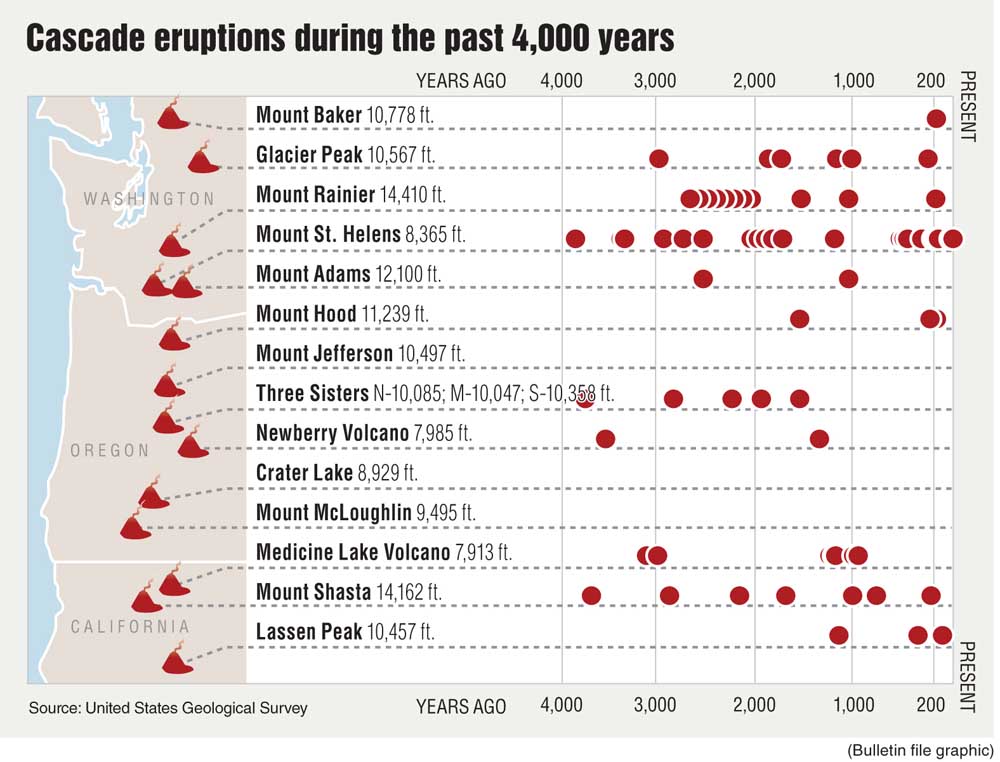Could a volcano erupt in Central Oregon?
Published 12:00 am Thursday, May 10, 2018

- History of volcanic eruption in the Cascades.
Kilauea volcano has drawn national attention in the last week, destroying structures and cracking open streets and property on Hawaii’s Big Island and filling them with lava.
As of Wednesday, 27 homes had been destroyed, and residents braced for the possibility of a more explosive eruption still to come, according to Hawaii County Civil Defense.
While Central Oregon has not seen eruptions like this for several centuries, the potential is there.
Volcanoes helped mold the region’s landscape, and still have the power to reshape it. Along with other parts of the Pacific Northwest, Central Oregon lies in the shadow of several volcanoes deemed a high priority by the U.S. Geological Survey. Even as recently as 2001 — barely a moment ago in geologic time — scientists marveled at an 80-square-mile bulge of lava growing four miles underground near South Sister.
“From a geologic perspective, it’s one of the most volcanically active parts of the country,” said Adam Kent, professor at Oregon State University’s College of Earth, Ocean, and Atmospheric Sciences.
Seth Moran, scientist-in-charge at the David A. Johnston Cascades Volcano Observatory, a Vancouver, Washington-based facility operated by the U.S. Geological Survey, said Oregon and Washington have about 25 active volcanoes, mostly clustered in and near the Cascade Mountain range.
The four Oregon sites deemed to be the highest priority, based on the likelihood of an eruption and their proximity to large population centers, are Mount Hood, Crater Lake, Newberry Volcano and the Three Sisters.
Mount Bachelor is considered a moderate threat, though Moran added that geologists now believe the volcano may be dormant.
While Oregon will almost certainly see a volcanic eruption again, Moran emphasized that there’s no reason to believe there’s one in the immediate future. He said none of Oregon’s volcanoes is showing signs of waking up, and any potential eruption could be centuries away.
Still, the Oregon Office of Emergency Management helped develop a coordination plan with various federal and state agencies for a potential volcanic eruption in the central Cascades, and an update to the plan is in process. Nathan Garibay, emergency services manager for Deschutes County, said authorities are ready for an eruption.
“Typically, we’d have some degree of warning where we could start to prepare our population,” Garibay said.
While Washington is known nationally for its volcanoes, thanks in part to the eruption of Mount St. Helens on May 18, 1980, Moran said Oregon has actually seen more molten rock over its geologic history than its neighbor to the north. However, the state’s volcanoes have been less active in modern history, as the most recent eruption in Oregon began on Mount Hood in 1781, more than two decades before Lewis and Clark began their expedition.
In particular, Central Oregon owes a lot of its most popular and striking natural features to volcanic eruptions over many millennia. Emilie Hooft, associate professor at the University of Oregon’s earth sciences department, said Newberry Volcano, a massive shield volcano with a caldera located about 20 miles southeast of Bend, created dramatic lava flows across south Deschutes County and the Lava Butte and Pilot Butte cinder cones.
Flows from the volcano, which last erupted around 600 A.D., redirected the Deschutes River, and have been found as far north as Smith Rock.
“Bend is built on lava flows that came out of Newberry,” Moran said.
Elsewhere in Central Oregon, scientists discovered a small bulge in the earth near South Sister in 2001, believed to be caused by molten rock near the Earth’s surface. Moran said the bulge began forming in 1997, and grew at a rate of about 3.5 centimeters per year.
“There was definitely cause for concern,” Kent added.
Since that time, however, the growth has slowed, with only 10 centimeters of uplift since 2001, according to Moran.
Any potential eruption in the Three Sisters would likely look somewhat different from what’s occurring in Hawaii’. Given that Bend, Sisters and Redmond are downwind of the mountains, Moran said ash could easily blanket the area. He added that lava could melt snow on the mountain, causing lahars — fast-moving flows of mud and other debris — that could travel down the mountain toward Central Oregon or the Willamette Valley.
On a prioritized list of natural disasters prepared by Deschutes County, volcanic eruptions ranked fifth out of nine potential hazards, according to Garibay. While a volcanic eruption would devastate the region, Garibay said the extreme improbability of it, as well as tell-tale signs like earthquake swarms, make it a lower priority than more likely and more sudden disasters.
Still, he said it’s a fact of life for Deschutes County and other population centers near the Cascades.
“All of us share this risk, because of where we’re located,” he said.
—Reporter: 541-617-7818, shamway@bendbulletin.com






